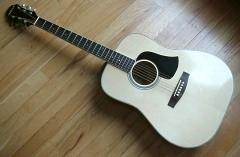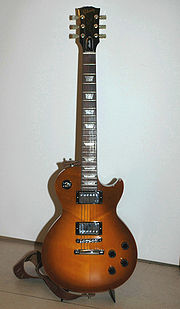吉他/分辨吉他种类
吉他分为许多种类,而每一种吉他都有其独特的音色。只有透过亲自弹奏才能真正了解各种吉他之间的差别。此外,由于每个人弹奏吉他的方式不同,一把吉他声音的好坏判定可能也会因人而异。
声学吉他[编辑]

声学吉他(acoustic guitars)在许多国家、各种类型的音乐中被广泛使用。声学吉他有许多种类,其中一些甚至很少被认为是吉他的一种,例如乌克丽丽(ukulele,见图)。吉他是现代社会中最流行的演奏乐器之一。

当提到声学吉他时,最多人会想到琴身上有一个音孔的“平型”(flat top)吉他。然而,吉他还有许多不同的外型和风格,每一种都有不同的音色。声学吉他有最主要的两个种类,分别是琴颈较小、使用钢铁弦的“铁弦吉他”(steel stringed),以及琴颈较宽、使用尼龙弦的“古典吉他”(classicals)。铁弦吉他的音色较为温和(虽然有时也会有金属的感觉),适合演奏广泛的流行音乐类型,包括乡村、流行和摇滚。古典吉他则大多用于演奏乡村蓝调、繁拍(ragtime)和民谣。两种吉他都能使用拨子(plectrum)或匹克(pick)以各种风格演奏。
每一种声学吉他的琴身都是中空而巨大的,以能让琴弦的声音能产生共鸣。曲线外型的大型琴身能造成更深沈或更沉重的音色,小型琴身的吉他则是为了让声音听起来更加明亮。
任何声学吉他的主体是大并中空的;它作为共鸣箱来放大吉他弦的声音。
电吉他[编辑]

w:zh:电吉他(electric guitar)是摇滚音乐的必备乐器,但也用在其它类型的音乐中,如蓝调,爵士和流行。 电吉他需要与放大器连接使其声音能让人听到。它们通常是实心吉他,但也有F孔的空心电吉他,这种结构赋予这种吉他一些声学共鸣(见下)。
十二弦吉他[编辑]

The twelve-string is usually an acoustic though twelve-string electric guitars are available. Twelve-string guitars are not the same as double-neck guitars. Double-neck guitars are essentially two guitar necks bolted onto one body. Twelve-string guitars have the regular six strings and a second set of thinner strings with each string of the second set corresponding to the note of its regular string counterpart. The second set of strings are tuned an octave higher. The strings form pairs; so you still play the guitar in the same manner as a standard six-string.
Twelve-string guitars produce a brighter and more prominent tone and are harder to play than a standard six-string guitar. They are usually confined to niche roles, such as rhythm guitar. The additional strings require more pressure to press down and bending notes also requires an extra muscular effort. Twelve-string guitars are more expensive to buy than the standard acoustic or electric and may need more maintenance because of the strain the additional strings place on the neck.
F 孔吉他[编辑]

An archtop is a hollow or semi-hollow acoustic or electric guitar which uses steel strings. The arched top creates a unique timbre and other elements taken from the design of the mandolin or violin also add to the distinctive tone of the archtop guitar. The body of the archtop guitar, whether hollow or semi-hollow, has a sound block in the middle and they also have violin f-holes cut into the table.
Archtop guitars may be acoustic or electric and can look very similar with the only distinguishing feature being an electromagnetic pickup. One problem with archtop hollow-bodied guitars is that when played through an amplifier they tend to generate feedback. The semi-hollow archtop was developed to make feedback less of an issue. Archtop guitars have been particularly popular in jazz music because their thicker strings add tone.
Some solid-body electric guitars have an arched top body shape but the name archtop is usually reserved for the hollow and semi-hollow guitar.
共鸣吉他[编辑]
Often also called 'steel' guitars due to some models possessing metal bodies. The acoustic resonator guitar is distinctive in not having a regular sound hole. Resonator guitars have a large, usually circular—plate which conceals the resonator cone. The cone closely resembles an audio loudspeaker and is made from spun aluminium. The bridge of the guitar is connected either to the centre of the cone or to the edge by an aluminium 'spider' and the strings' vibrations are thus amplified and projected outwards through the perforated plate on the guitar's top. The most common resonator guitars have a single cone, although the original model has three. Resonators possess a loud, bright voice, making them easily heard in a large room or open air performance. They are popular with blues musicians and country players and can be played in the conventional style or with a metal or glass slide.
低音吉他(贝斯)[编辑]
The bass guitar has a longer scale-length and thicker strings than a standard guitar. These factors create a range of notes that are pitched an octave lower than the guitar. Often the bass is considered part of the rhythm section but there are some players whose skills are comparable to any other soloist. Acoustic and electric bass guitars are available but the electric bass is more common. The standard bass is the four string bass though five and six string basses are also manufactured. The four strings of the bass correspond to the lowest four strings of the guitar an octave lower.
双颈吉他[编辑]
The double-neck guitar is basically two different kinds of guitar sharing one body. This design allows the guitarist to easily access and switch between either neck. Made famous by Jimmy Page, the double neck guitar typically will have a standard six-string neck and a twelve-string neck. Other combinations exist, such as a six-string and bass or a six-string with frets and its fretless version. Steve Vai has been known to play a triple-neck guitar. The double-neck guitar came about in the 1970s because of the changes in recording technology. The recording technology of the 1960s relied on only 4 tracks and multi-layered guitar parts, though possible, were not frequently used. The bands of the 1960s would usually have two guitarists and this achieved the desired affect. The invention of 8 track recording meant more freedom to create complex guitar parts. The guitarist could lay down the rhythm track using a twelve-string guitar and then record onto a separate track, the lead break using a six-string guitar. This left the problem of how a single guitarist could perform these parts live without stopping to change guitars and the double-neck guitar provided the solution.
